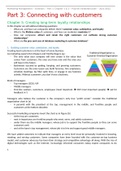Marketi ng Management – Summary – Part 1: Chapter 1 & 2 – Pauline Vandenbroucke – 2021/2022
Part 3: Connecting with customers
Chapter 5: Creating long-term loyalty relationships
In this chapter we will address following questions:
- What are, and how can companies deliver them? customer value, satisfaction, and loyalty
- What is the lifetime value of customers, and how can marketers maximize it?
- How can companies attract and retain the right customers and cultivate strong customer
relationships?
- What are the pros and cons of database marketing & customer database?
1. Building customer value, satisfaction, and loyalty
Creating loyal customers is at the heart of every business.
As marketing experts Don Peppers and Martha Rogers say:
- The only value your company will ever create is the value that
comes from customers, the ones you have now and the ones you
will have in the future.
- Businesses succeed by getting, keeping, and growing customers.
Customers are the only reason you build factories, hire employees,
schedule meetings, lay fiber optic lines, or engage in any business
activity. Without customers, you don’t have a business.
Kinds of managers
- Top managers (CEO): VIP
- Middle managers
- First-line workers, customers, employees (most important MIP most important people) ask for
feedback (+/-)
Managers who believe the customer is the company’s only true “profit center” consider the traditional
organization chart in (a)
- A pyramid with the president at the top, management in the middle, and frontline people and
customers at the bottom obsolete.
Successful marketing companies invert the chart as in Figure (b).
- At the top are customers.
- next in importance are frontline people who meet, serve, and satisfy customers.
- under them are the middle managers, whose job is to support the frontline people so they can serve
customers well.
- and at the base is top management, whose job is to hire and support good middle managers.
We have added customers to indicate that managers at every level must be personally involved in knowing,
meeting, and serving customers. Some companies have been founded with the customer-on-top business
model, and customer advocacy has been their strategy and competitive advantage all along. With the rise of
digital technologies such as the Internet, increasingly informed consumers today expect companies to do
1
,more than connect with them, more than satisfy them, and even more than delight them. They expect
companies to listen and respond to them.
2. How do customers make choices?
How then do customers ultimately make choices?
They tend to be value maximizers, within the bounds of search costs and
limited knowledge, mobility, and income. Customers estimate which offer
they believe—for whatever reason—will deliver the most perceived value
and act on it (Figure 5.2). Whether the offer lives up to expectation affects
customer satisfaction and the probability that the customer will purchase the
product again.
Customer Perceived Value
Consumers are better educated and informed than ever, and they have the
tools to verify companies’ claims and seek out superior alternatives.
Customer-perceived value (CPV) is the difference between the prospective
customer’s evaluation of all the benefits and all the costs of an offering and
the perceived alternatives. Total customer benefit is the perceived monetary
value of the bundle of economic, functional, and psychological benefits
customers expect from a given market offering because of the product,
service, people, and image. Total customer cost is the perceived bundle of
costs customers expect to incur in evaluating, obtaining, using, and disposing
of the given market offering, including monetary, time, energy, and
psychological costs.
Customer-perceived value is thus based on the difference between benefits
the customer gets and costs he or she assumes for different choices. The
marketer can increase the value of the customer offering by raising
economic, functional, or emotional benefits and/or reducing one or more
costs. The customer choosing between two value offerings, V1 and V2, will
favor V1 if the ratio V1:V2 is larger than one, favor V2 if the ratio is smaller
than one, and be indifferent if the ratio equals one.
Applying value concepts
- Very often, managers conduct a customer value analysis to reveal the company’s strengths and
weaknesses relative to those of various competitors. The steps in this analysis are:
1. Identify the major attributes and benefits customers value.
2. Assess the quantitative importance of the different attributes and benefits.
3. Assess the company’s and competitors’ performances on the different customer values against
their rated importance.
4. Examine how customers in a specific segment rate the company’s performance against a specific
major competitor on an individual attribute or benefit basis.
5. Monitor customer values over time.
2
, Example
Suppose the buyer for a large construction company wants to buy a tractor for residential construction from
either Caterpillar or Komatsu. He wants the tractor to deliver certain levels of reliability, durability,
performance, and resale value. The competing salespeople carefully describe their respective offers. The buyer
decides Caterpillar has greater product benefits based on his perceptions of those attributes. He also perceives
differences in the accompanying services—delivery, training, and maintenance—and decides Caterpillar
provides better service as well as more knowledgeable and responsive staff. Finally, he places higher value on
Caterpillar’s corporate image and reputation. He adds up all the economic, functional, and psychological
benefits from these four sources—product, services, personnel, and image—and perceives Caterpillar as
delivering greater customer benefits.
Does he buy the Caterpillar tractor? Not necessarily. He also examines his total cost of transacting with
Caterpillar versus Komatsu, which consists of more than money. As Adam Smith observed over two centuries
ago in The Wealth of Nations, “The real price of anything is the toil and trouble of acquiring it.” Total customer
cost also includes the buyer’s time, energy, and psychological costs expended in product acquisition, usage,
maintenance, ownership, and disposal. The buyer evaluates these elements together with the monetary cost to
form a total customer cost. Then he considers whether Caterpillar’s total customer cost is too high compared
to total customer benefits. If it is, he might choose Komatsu.
The buyer will choose whichever source delivers the highest perceived value. Now let’s use this decision-
making theory to help Caterpillar succeed in selling to this buyer. Caterpillar can improve its offer in three
ways. First, it can increase total customer benefit by improving economic, functional, and psychological
benefits of its product, services, people, and/or image. Second, it can reduce the buyer’s nonmonetary costs by
reducing the time, energy, and psychological investment. Third, it can reduce its product’s monetary cost to the
buyer. Suppose Caterpillar concludes the buyer sees its offer as worth $20,000. Further, suppose Caterpillar’s
cost of producing the tractor is $14,000. This means Caterpillar’s offer generates $6,000 over its cost, so the
firm needs to charge between $14,000 and $20,000. If it charges less than $14,000, it won’t cover its costs; if it
charges more, it will price itself out of the market. Caterpillar’s price will determine how much value it delivers
to the buyer and how much flows to Caterpillar. If it charges $19,000, it is creating $1,000 of customer
perceived value and keeping $5,000 for itself. The lower Caterpillar sets its price, the higher the customer
perceived value and, therefore, the higher the customer’s incentive to purchase. To win the sale, the firm must
offer more customer perceived value than Komatsu does.10 Caterpillar is aware of the importance of taking a
broad view of customer value.
Choice processes and implications
- Some marketers might argue the process we have described is too rational. Suppose the customer
chooses the Komatsu tractor. How can we explain this choice? Here are three possibilities.
1. The buyer might be under orders to buy at the lowest price. The Caterpillar salesperson’s task is then
to convince the buyer’s manager that buying on price alone will result in lower longterm profits and
customer value.
2. The buyer will retire before the company realizes the Komatsu tractor is more expensive to operate.
The buyer will look good in the short run; he is maximizing personal benefit. The Caterpillar
salesperson’s task is to convince other people in the customer company that Caterpillar delivers
greater customer value.
3





